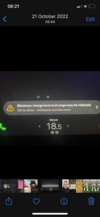Was told by Chester SC in October my Dec 2021 M3P needed a new HV Battery and the replacement was fitted 10 days ago.
I followed it’s progress on the app and noticed the range at 100% charge was 289 miles. This is roughly 10% less than the original battery.
I messaged the SC raising concerns about this as the charging stats match the Dec 2019 M3P model which has the smaller 75 KWH battery.
I enquired on 9 occasions if the replacement HV battery fitted was the 82KWH capacity battery and not the 75 KWH battery fitted to older models, but the answer was not forthcoming. The SC were able to confirm it’s a refurbished battery though.
I was then contacted by the SC manager who informed me they don’t know what the KWH capacity is but it is the correct battery.
I asked if they could make enquiries with the supplier or colleagues to establish the KWH capacity of the battery but they won’t do this. I asked if I could have the supplier’s details so I could make enquiries but they avoided the question.
I was then told to email [email protected]. I doubt they’ll know what the capacity is? I find this very strange….Is it a secret??
The SC manager then stopped my ability to reply by closing down the Service on the App.
I’m pretty confident my concern could have been resolved with a phone call or email.
The part number for the ‘new’ battery is:
ASY,HVBAT,E3,AWD,3PH,M3Y,RMN (1800083-01-C)
Anyone know how to find more information about the battery with the part number?
Many thanks
I followed it’s progress on the app and noticed the range at 100% charge was 289 miles. This is roughly 10% less than the original battery.
I messaged the SC raising concerns about this as the charging stats match the Dec 2019 M3P model which has the smaller 75 KWH battery.
I enquired on 9 occasions if the replacement HV battery fitted was the 82KWH capacity battery and not the 75 KWH battery fitted to older models, but the answer was not forthcoming. The SC were able to confirm it’s a refurbished battery though.
I was then contacted by the SC manager who informed me they don’t know what the KWH capacity is but it is the correct battery.
I asked if they could make enquiries with the supplier or colleagues to establish the KWH capacity of the battery but they won’t do this. I asked if I could have the supplier’s details so I could make enquiries but they avoided the question.
I was then told to email [email protected]. I doubt they’ll know what the capacity is? I find this very strange….Is it a secret??
The SC manager then stopped my ability to reply by closing down the Service on the App.
I’m pretty confident my concern could have been resolved with a phone call or email.
The part number for the ‘new’ battery is:
ASY,HVBAT,E3,AWD,3PH,M3Y,RMN (1800083-01-C)
Anyone know how to find more information about the battery with the part number?
Many thanks



